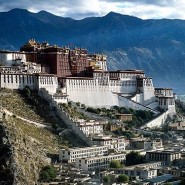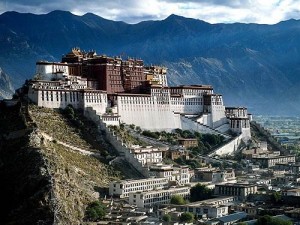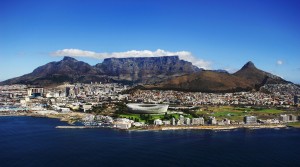The Seven Trials of Tibet

Experience #936
Hoping to tread the path to enlightenment I took the Tibetan challenge and travelled the rough road from Katmandu to Lhasa discovering a rural land trapped in time and ruled by religion.
Himalayan hidden and oft-shrouded in secrecy, Tibet has always attracted attention because of its blocked borders. More recently Tibet’s political plight and the Dalai Lama’s celebrity connections have piqued the world’s interest in what really exists within. To many, the very mention of Tibet conjures up images of a land long locked in mystery where Buddhist monks levitate above the roof of the world, attaining peace and perspective from their lofty view.
Not that I want to be the one responsible for popping political balloons and denouncing media-manufactured mystery but let’s dispense with romantic notions upfront and tell it like it is: a journey to Tibet is not the promised Shangri-la of Hollywood hype but a hard slog.
Annexed by China in 1950, Tibet only opened its borders in the mid-80s and is still largely un-touristed. No walk in the park, facilities are limited outside the capital Lhasa, the countryside inhospitable and the Chinese landlords ever present, but for those hungry for adventure the rewards are great.
Up for the challenge? Prepare yourself for the seven trials of Tibet:
1. The altitude
With a consistent altitude of between 3800 to 5500 metres Tibet is tough work on the lungs. Put good physical condition aside as altitude sickness affects everyone differently.
Leaving Katmandu in a Nepalese-organised minivan with my five fellow explorers Bob from Chicago, two Spanish women both called Maria Jose; David, also Spanish, and our Tibetan guide Toshi it wasn’t long before we were all feeling lightheaded.
Climbing from the lush rice terraces of Katmandu into the barren Himalayan hills I attributed my slight intoxication to excitement not altitude sickness. Distracted by the surrounding scenic snow-capped peaks and intrigued by mountaintops littered with flapping prayer flags and discarded yak horns, I took little notice of my condition. Better if I had. By evening I was drunk on the thin mountain air. The Himalayan heights literally taking my breath away and giving me a headache worse than any hangover I’ve ever known. Dizziness and shortness of breath followed.
By the second day it was worse. My pounding headache was accentuated by every bump in the country’s pockmarked roads. My sickness culminating in a need to vomit, I ordered the van to stop. The Spanish women rushed to offer headache pills while our guide volunteered a thermos of hot water. Both had affect and took the edge off my symptoms, but the only real cure for altitude sickness is acclimatizing or, in more serious cases, to descend to a safe altitude where the symptoms disappear almost magically.
Suffering, I soldiered on. By the afternoon, I was better acclimatized to enjoy the view of Mt Everest haunting the horizon. Taking a roadside moment to marvel at the majestic mountain I wondered how man finally managed to claim it. I released in my present state of anti-altitude adaptation, my dream to scale Everest would never come true. This was as close as I would get, so I’d best soak it in.
2. The roads
Forget about paved road comfort during your Tibetan trip. It’s not a luxury you’re likely to enjoy. In fact during the entire seven-day trek from Katmandu to Lhasa the only significant stretch of paved road encountered along the Friendship Highway was during the last 90km outside the Tibetan capital.
Make no mistake the roads are rugged. Offering spectacular scenery, at times the ribbon of road clinging to the mountainside narrows to give a stomach-sinking vertical view of a river far below. Another time we drove through a glacier that had edged across the road. And on one particular spine shaking bump the back window of our van shattered bringing new meaning to the term air-conditioning.
Not that we needed it. Tibet is warm during the day, and the open window only invited more of the dry, arid landscape into the mini-van. Broken window or not, dust is a problem. My bags were covered in it; my clothes were too; and worst of all my throat and nose were coated inside and out.
The Maria Jose-s improvised by cleverly wrapping toilet paper around their faces. Dubbing them the “toilet paper bandits”, it was a look I wasn’t man enough to adopt myself but next time I’ll remember to pack a dust mask.
3. The food & accommodation
Tibetan food should be approached cautiously. Perhaps this is why you don’t see a proliferation of Tibetan restaurants around the world. The food is awful. Standard fare consists of a doughy bread that upon closer inspection looked un-baked; too many fried eggs and meat that in its appearance alone is enough to make the most ardent carnivore think about adopting vegetarianism.
The accommodation isn’t much better. Typical Tibetan homes consist of two and three story square houses slanted slightly inwards, their white walls accented by black windows. Inside, low ceilings keep the heat in, while heavy door-hangings keep the crisp mountain air out. Accommodation in local hotels consists of a small square room with nothing more than two single beds and enough heavy blankets to suffocate you in the night. Careful you don’t bump your head on the locally designed ceiling. Chinese hotels are slightly better but less charming.
With plumbing severely limited outside of Lhasa, toilets are of the squat and drop variety. Not fun when finding your way in through the darkness in the cold mountain night air. Without a flashlight one false step could be disastrous.
4. The language
Not even on the United Nation’s list of nine official languages. Tibetan is hard to master and community colleges are not exactly brimming with courses offering the opportunity to study. Even our guide, Toshi, an enthusiastic Chinese-trained Tibetan, English skills were extremely limited. More frustrating then informative, when asked about why pilgrims prostrate themselves at temples she replied, “No, we go to the local medical clinics for that sort of problem”.
Unfortunately, limited language can mean limited exposure to the Tibetan people. But all is not lost. Although shy, Tibetan’s innate sense of curiosity often gets the better of them and as I found, they may in fact be the ones approaching you.
Coming across a construction site I found the tables turned, when the locals proved equally interested in me as I was in them. The tourist had become the attraction. My attempt at taking photos was thwarted by these camera shy locals, who were nonetheless photo-fascinated, expressing great delight when I handed my camera to them so that they might snap the shutter.
5. Yak butter
Yes! Yak butter. Integral to Tibetan temple life, I discovered it is the only thing in the world that I am allergic to.
The highly perfumed lard pervades the dark and musty monastery temples. No sooner would I wander into one of these temples then my already oxygen deprived nose would stuff up and I would start to sneeze uncontrollably.
Still the Tibetan temples are well worth the inconvenience of not breathing. Like a set straight out of Indiana Jones, the temples are draped in silks darkened by the burning yak butter no less. Light is limited to the illumination provided by yak vat flames.
Wondering clockwise around these shadow-strewn candlelit temples, somber clad pilgrims each carry a golden chalice of yak butter. Chanting prayers before vats of the stuff, they offer a melted drop of their own butter to the temple’s tub in the hope that their prayers will be granted.
6. The gods and symbols
Identifying and understanding all the Buddhist gods, statues of former Dalai Lamas, and symbols adorning temples is a huge Tibetan task. Inside the monastery’s temples, maroon wrapped monks preside over altars resplendent with a mind-boggling array of Buddhist deities and gold enameled incarnations of past Dalai Lamas. (The exiled Dalai Lama is not acknowledged nor discussed under the Chinese regime – even our Tibetan guide avoided direct answers on the subject.) After a while they all start to look the same, their significance lost. A good guidebook to the Gods would have definitely come in handy.
Count yourself lucky that you’re not Tibetan, as those monks not getting their lessons and prayers correct are believed to slip on the reincarnation ladder and come back as one of the many surly dogs resident at temples throughout the country.
Oddly enough, one popular symbol in Tibet comes from the West. Confounded by the number of Chicago Bulls hats worn in the country – does the team have an exclusive Tibetan franchise? – it finally dawned on me. With the yak as the country’s most venerated animal, its not Michael Jordan that has Tibetans wearing their Chicago Bulls hat, but the team’s logo that, to Tibetan eyes, looks like a yak! Wear one and you’ll be an instant hit.
7. The politics
Seeing through to the heart of Tibet is difficult. As China continues its deliberate policy to corrupt the indigenous Tibetan culture with the steady immigration of Han Chinese they may one day outnumber the Tibetans in their own country.
 The Potala Palace remains a Tibetan cornerstone. A privileged peak into the country’s centuries-old seat of power, majestically perched atop the city, reveals larger and grander temples lined with huge bookshelves of dusty Tibetan tomes than elsewhere in the country. Of particular interest, the modest rooftop apartments the deposed 14th Dalai Lama left behind when he fled to India in the fifties.
The Potala Palace remains a Tibetan cornerstone. A privileged peak into the country’s centuries-old seat of power, majestically perched atop the city, reveals larger and grander temples lined with huge bookshelves of dusty Tibetan tomes than elsewhere in the country. Of particular interest, the modest rooftop apartments the deposed 14th Dalai Lama left behind when he fled to India in the fifties.
Despite the Potala no longer acting as a seat of government the palace is still animate with numerous monks scurrying about, while others, sequestered away in tourist-restricted rooms, chant – their incantations audible throughout the palace.
For a truly undiluted look at life in Tibet before the Chinese I discovered Lhasa’s Jokhang Temple and adjoining Barkhor Market. The most peopled place in Lhasa, this humble temple has monks aplenty and is of great religious significance to the country’ faith.
Layered like an onion, the temple’s exterior is encircled by the busy Barkhor Market. Catering to both locals and tourists, stalls with fur hats, heavy door hangings, turquoise jewellery, paintings and prayer wheels offered along side groups of busking burgundy-robed monks, make it one of the best places to see daily life and pick up a souvenir at the same time.
The temple’s inner sanctum offers yet another layer. Awash with flickering candles reflected in melted pools of yak butter, pilgrims chant while, with an imperceptible flick of their wrist, they keep their personal prayer wheel magically spinning. Monks gathered under the courtyard canopy beat drums, blow long alpine horns, and chant in unison only to find themselves the subject of another tourist’s lens but they seem not to mind.
Outside the temple prostrating pilgrims armed with knee and hand pads they drop to their knees, then fall flat against the ground, before getting up and dropping down again. In this slow and somewhat ‘hard on the knees’ manner once yearly every good Tibetan makes a ritual circuit of the city demonstrating devotion to their Buddhist faith.
Nevertheless Tibetan tradition is slowly slipping under the weight of the Chinese and anyone with romantic visions of Tibet is advised to include it on their got-to-go list before it vanishes completely and simply becomes another province of China.
Altitude Sickness
Those with heart trouble or breathing difficulties such as asthma might want to check with a physician for preventative medicine before exposing themselves to the extreme altitudes of the Himalayas.
Any traveler to Tibet should be aware of the dangers of altitude sickness. Problems occur in the altitudes above 2400m and are a result of ascending to high altitudes too quickly – such as flying directly into Lhasa which sits close to 4000m. Symptoms of faster and harder breathing, a pounding heart, headaches and possible swelling of ankles and hands can occur one to three days after arrival as your body seeks to cope with the thinner air. The trick is to take it easy for the first couple of the days as your body acclimatises to the new altitude.





That sounds like it was quite the experiance. Tibet has never really been on my list…perhaps I am too citified for this type of adventure. Thanks for sharing.
I might recommend Bhutan over Tibet if you want to travel to that region of the world.